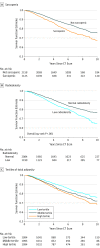Association of Muscle and Adiposity Measured by Computed Tomography With Survival in Patients With Nonmetastatic Breast Cancer
- PMID: 29621380
- PMCID: PMC6584322
- DOI: 10.1001/jamaoncol.2018.0137
Association of Muscle and Adiposity Measured by Computed Tomography With Survival in Patients With Nonmetastatic Breast Cancer
Abstract
Importance: Sarcopenia (low muscle mass), poor muscle quality (low muscle radiodensity), and excess adiposity derived from computed tomography (CT) has been related to higher mortality in patients with metastatic breast cancer, but the association with prognosis in patients with nonmetastatic breast cancer is unknown.
Objective: To evaluate associations of all 3 body composition measures, derived from clinically acquired CT at diagnosis, with overall mortality in nonmetastatic breast cancer.
Design, setting, and participants: This observational study included 3241 women from Kaiser Permanente of Northern California and Dana Farber Cancer Institute diagnosed from January 2000 to December 2013 with stages II or III breast cancer. We calculated hazard ratios (HRs) to evaluate the associations of all-cause mortality with sarcopenia, low muscle radiodensity, and total adipose tissue (TAT). Models were adjusted for sociodemographics, tumor characteristics, treatment, body mass index (BMI; calculated as weight in kilograms divided by height in meters squared), and other body composition measures. We also evaluated the cross-classification of categories of sarcopenia (yes/no) and tertiles of TAT, with outcomes.
Main outcomes and measures: Overall survival time and all-cause mortality.
Results: Median (range) age of 3241 women included in this study was 54 (18-80) years, and median follow-up was 6.0 years; 1086 patients (34%) presented with sarcopenia, and 1199 patients (37%) had low muscle radiodensity. Among patients with nonmetastatic breast cancer, those with sarcopenia showed higher overall mortality (HR, 1.41; 95% CI, 1.18-1.69) compared with those without sarcopenia. Patients in the highest tertile of TAT also showed higher overall mortality (HR, 1.35; 95% CI, 1.08-1.69) compared with those in the lowest tertile. Low radiodensity was not associated with survival. In analyses of sarcopenia and TAT, highest mortality was seen in patients with sarcopenia and high TAT (HR, 1.89; 95% CI, 1.30-2.73); BMI alone was not significantly related to overall mortality and did not appropriately identify patients at risk of death owing to their body composition.
Conclusions and relevance: Sarcopenia is underrecognized in nonmetastatic breast cancer and occurs in over one-third of newly diagnosed patients. Measures of both sarcopenia and adiposity from clinically acquired CT scans in nonmetastatic patients provide significant prognostic information that outperform BMI and will help to guide interventions to optimize survival outcomes.
Conflict of interest statement
Figures
Comment in
-
Obesity, Body Composition, and Breast Cancer: An Evolving Science.JAMA Oncol. 2018 Jun 1;4(6):804-805. doi: 10.1001/jamaoncol.2018.0125. JAMA Oncol. 2018. PMID: 29621383 No abstract available.
-
Body Composition and Overall Survival in Patients With Nonmetastatic Breast Cancer.JAMA Oncol. 2019 Jan 1;5(1):114-115. doi: 10.1001/jamaoncol.2018.5290. JAMA Oncol. 2019. PMID: 30476943 No abstract available.
-
Body Composition and Overall Survival in Patients With Nonmetastatic Breast Cancer-Reply.JAMA Oncol. 2019 Jan 1;5(1):115-116. doi: 10.1001/jamaoncol.2018.5299. JAMA Oncol. 2019. PMID: 30476978 No abstract available.
References
-
- Ligibel JA, Wollins D. American Society of Clinical Oncology obesity initiative: rationale, progress, and future directions. J Clin Oncol. 2016;34(35):4256-4260. - PubMed
Publication types
MeSH terms
Grants and funding
LinkOut - more resources
Full Text Sources
Other Literature Sources
Medical
Miscellaneous


